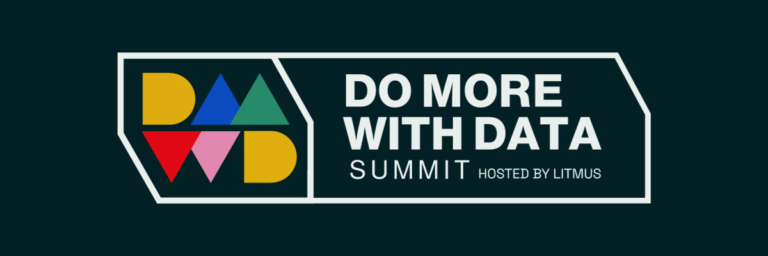Do More With Data Summit: Session Summary and Take Aways – Nov 2023

Access the full recordings here.
If you’re an Industry 4.0 enthusiast, imagine the power of having a team of experts, doers, and IIoT leaders shepherding you through the latest digital transformation tools, industry 4.0 insights, and best practices.
That’s exactly what was on offer November 8 & 9, 2023, at the free, biannual “Do More With Data” Summit from Litmus. Close to 1000 registrants, 24 speakers, several valued partners, and a host of manufacturing industry influencers gathered online over 2 days to share their knowledge and actionable insights. And if you missed it this time around, here’s a summary of the experts involved, and the topics discussed.
Whether you’re interested in upskilling your workforce, real-world Industry 4.0 use-cases, democratizing your data or Shadow IT, you’ll find something here that you can use to accelerate your digital transformation efforts.
From shop floor to a new live stream
Day 1 of the Summit kicked off on an authentic note—right from the shop floor of Marson Foods, where COO Tyler Wallace confirmed that digital transformation is good for the bottom line in manufacturing and that it’s been a “great driver of efficiency and increased productivity” in their workplace.
Harnessing data, advised Wallace, allows employees to “use their brains more than their brawn”, which results in more valuable, satisfied, and productive employees.
Next up was Litmus’ own Marc Dekker and Dave McMorran, who teased an introduction to their new, upcoming bi-weekly live cast—DMWD Live. “It’ll be kind of like a podcast but with video on LinkedIn”, according to Marc, where he and Dave will riff with Industry 4.0 experts, influencers, and special guests. Have a topic you’d love to know more about? Get in touch with us and maybe even volunteer to be a guest yourself!
Pitfalls & progress of “democratizing your data”
The summit then focused on some real-world examples and pitfalls of collecting and disseminating data at the at the edge of the manufacturing tech stack.
Brent Erb from Philips cautioned that many data operations collect data but fail to automate it or get it to the people and processes that need it the most. He gave an example from their own shop floor where data was compiled on the costs of no-quality products but that “nobody looked at it.”
A common theme that emerged from this session was summed up succinctly by industry consultant John Piller, advising that manufacturers need to “democratize your data…if you want to make it to 2060.”
Dealing with legacy systems…to buy or to build?
Automating, digitizing, and democratizing data may sound great in theory, but with legacy systems in place, knowing where to start (and how to complete) these complex integrations can be daunting.
William VanBuskirk, Product Manager at Tulip, says that before you embark on any new data digitization and integration project, you must first consider “what use-cases it’s solving.” Sean Callahan, (also from Tulip), says that whether you buy or build a new data operations solution, “it has to be a collaborative process” and that in your “center of excellence… you must include the whole ecosystem of people who will be using the solution the most.”
Day 2 – Collaboration vs Shadow IT
The momentum continued on Day 2 where the overall theme underscored the need for integration and collaboration between the “office and the shop floor.” Data operations cannot operate in a silo—and success is contingent on solving articulated business needs.
“There’s no secret sauce in data strategy,” according to Charlie Sheridan from Google. There has to be a defined benefit for the organization from the outset. When you go into a pilot opportunity, he says, “design the solution around the challenges,” adding, “you need to have the right people in the room together. Alignment is key.”
Of course, sometimes there can be misalignment between functional units—where immediate needs may sometimes trump more formal processes already in place. “Shadow IT” operations can emerge on the shop floor to address this apparent misalignment.
Shadow IT is due to a need for data. When a facility needs data and cannot obtain it from the standard enterprise systems, Shadow IT “is a form of Innovation to get the job done” according to Marc Dekker from Litmus.
Although Sheila Kester from TwinThread agreed with Marc, she advised that manufacturing operations need to weigh the risks vs rewards when considering a Shadow IT solution. “Shadow IT is innovation” she says, but cautions that it “should be embraced in a logical, secure way.”
Data Contextualization and Value
The summit wrapped up with a discussion about the need for contextualized data with the bold assertion form Sheila Kester that “contextualization will be mandated.” She added, “don’t give me data I don’t need.” Recognize the roles that need to see the data, and “eliminate everything that’s extraneous.”
Chris Lueke, from the Manufacturing Happy Hour podcast reminded all attendees to ultimately “treat data as an asset”, which was echoed in one way or another by all guests, partners, and panelists throughout the summit.
And finally, Michael Jerzykowski from Torani capped off the summit by advising attendees to “partner with a company that has a track record of achieving the goals you want to achieve. Bring the right people to the table to know what you don’t know.” We couldn’t have summarized it better ourselves, Michael.
